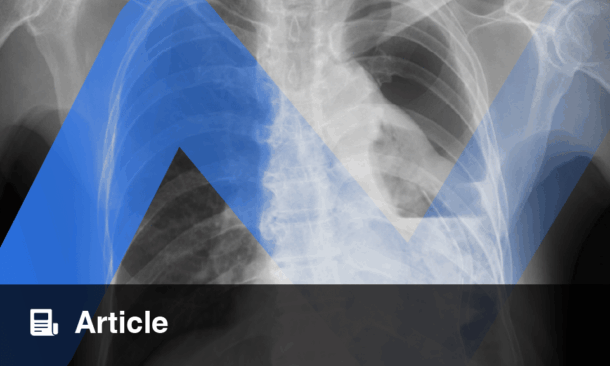Interview Summary
Although HER2 mutations occur in only 2–4% of non-small cell lung cancer (NSCLC) cases, patients with HER2-mutant NSCLC have historically faced limited treatment options and poor outcomes with chemotherapy. Recent data from the Beamion LUNG-1 study demonstrated the efficacy of zongertinib, an orally administered HER2-selective tyrosine kinase inhibitor, which provided a 75% objective response rate (ORR) with durable responses in heavily pretreated patients. Based on these results, the U.S. FDA recently granted accelerated approval for zongertinib for the treatment of adult patients with unresectable or metastatic NSCLC whose tumors have HER2 tyrosine kinase domain (TKD) activating mutations, and who have received prior systemic therapy. In an interview with the American Medical Journal (AMJ), Joshua Sabari, a thoracic oncology expert at NYU Langone Health’s Perlmutter Cancer Center, New York, USA, shared insights into recent advances in the second-line treatment of HER2-mutant NSCLC. He emphasized the importance of comprehensive molecular testing to identify HER2 mutations, noting that many community oncologists may not routinely test for these alterations. Sabari also discussed recent data from the Beamion LUNG-1 study demonstrating the efficacy and safety of zongertinib in patients with HER2-mutant NSCLC, noting its favorable safety profile and the improvements in patient-reported outcomes (PRO), particularly pain and physical functioning. Finally, he provided important practical advice for community oncologists treating patients with previously treated HER2-mutant NSCLC.INTRODUCTION
Mutations in HER2, also known as ERBB2, occur in 2–4% of patients with NSCLC and are more prevalent among never smokers, women, and patients with adenocarcinoma histology.1-3 HER2 mutations in NSCLC predominantly affect the TKD, which is encoded by exons 18–24 of the gene. However, clinically relevant activating mutations can also occur outside the TKD.3,4
Sabari explained that HER2 alterations in NSCLC are different from those in HER2-positive breast and gastric cancers. “In breast cancer and gastric cancer, we’re typically looking at HER2 overexpression. It is a protein on the cell surface, and we’re measuring this by immunohistochemistry,” he noted. He further elaborated that in NSCLC, most HER2 alterations are exon 20 insertion mutations, which are oncogene driver mutations.3,4 “These mutations are identified by tissue and liquid next-generation sequencing, are highly active, and [are] highly responsive to targeted therapies,” he said.
Current Treatment Landscape and Unmet Needs
Sabari emphasized the importance of comprehensive molecular testing in the management of HER2-mutant NSCLC. “I would not give any patients systemic therapy without having the molecular test result,” he noted. This approach is supported by studies showing that patients with driver mutations demonstrate superior outcomes with targeted therapy compared to chemotherapy combinations.5
In the front-line setting, standard of care for advanced or metastatic HER2-mutant NSCLC is platinum-based chemotherapy, typically carboplatin and pemetrexed, with or without pembrolizumab.6,7 Until recently, the most commonly used therapies for previously treated patients with HER2-mutant NSCLC were immunotherapy alone or in combination with chemotherapy, non-platinum-based chemotherapy, and HER2-directed therapy.8
However, Sabari uses immunotherapy with caution in this population. “I generally avoid using programmed cell death protein 1 (PD-1) inhibitors, particularly in my never smokers or patients with low [programmed death-ligand 1] PD-L1 expression, because the activity for PD-1 or PD-L1 inhibitors is low,” he explained. “I worry about the potential toxicity in combinations.”
The median progression-free survival (PFS) with standard chemotherapy approaches is 4–7 months in patients with metastatic HER2-mutant NSCLC, highlighting the high-risk nature of this molecular subtype of lung cancer and the need for more effective targeted therapies.9
BEAMION LUNG-1: EFFICACY AND SAFETY OF ZONGERTINIB IN HER2-MUTANT NON-SMALL CELL LUNG CANCER
Study Design
The Beamion LUNG-1 trial was a Phase Ia dose-escalation study, followed by a Phase Ib dose-expansion study, evaluating the efficacy and safety of zongertinib in patients with HER2-mutant NSCLC.10 Zongertinib is an orally administered, irreversible, and potent tyrosine kinase inhibitor that demonstrates high selectivity for HER2 while sparing wild-type EGFR and recently received accelerated FDA approval based on data from the Beamion LUNG-1 Phase Ib clinical trial.10-14
Sabari explained that the study enrolled multiple cohorts, addressing different clinical scenarios that oncologists may encounter in practice. The study included patients with TKD mutations who had previously received chemotherapy with or without immunotherapy (Cohort 1); patients with non-TKD mutations who had previously received treatment (Cohort 3); and patients with TKD mutations who had received chemotherapy with or without immunotherapy, and subsequently received HER2-directed antibody–drug conjugates (ADC; Cohort 5).10 The study also enrolled treatment-naive patients with TKD mutations (Cohort 2) and patients with TKD mutations and active central nervous system (CNS) metastases (Cohort 4). Data for these cohorts were presented at congresses in September and October 2025.10
Efficacy Outcomes
Sabari described the results from Cohort 1 of Beamion LUNG-1 as practice-changing, stating that “the Phase Ib expansion led to the FDA approval of zongertinib in the second-line setting.” Zongertinib has been approved for the treatment of adult patients with unresectable or metastatic NSCLC whose tumors have HER2 (ERBB2) TKD activating mutations, as detected by an FDA-approved test, and who have received prior systemic therapy.11 In the August 2025 update of the National Comprehensive Cancer Network (NCCN) clinical practice guidelines on NSCLC, zongertinib has also been added as a preferred subsequent therapy option for patients with advanced or metastatic HER2-mutant NSCLC who have received prior systemic therapy.15
In the Beamion LUNG-1 study, among 75 patients with TKD mutations in Cohort 1 who were treated with zongertinib 120 mg once daily, the confirmed ORR was 71% (95% CI: 60–80%), with 7% of patients showing complete responses and 64% showing partial responses.10
He characterized the 71% ORR as “impressive,” and explained that with patient regrouping in the application for FDA approval, the ORR is even higher at 75% (95% CI: 63–83%).11 The revised Cohort 1 included 71 patients with TKD mutations who received prior treatment with chemotherapy with or without immunotherapy (n=69) and anti-HER2 monoclonal antibodies (n=2).11
Responses with zongertinib treatment in previously treated patients with TKD mutations (Cohort 1) were durable, with 58% of patients showing a duration of response of 6 months or longer.11 “At the initial data cut off, about half of patients remained on treatment,” he highlighted.
He put these efficacy outcomes into context, emphasizing that they represent a substantial improvement over historical control data. “Treatment with chemotherapy or chemotherapy and immunotherapy leads to, on average, a 7-month median PFS, so to see a near doubling of that number is quite impressive,” he remarked.
He added that treatment with the ADC trastuzumab deruxtecan (5.4 mg/kg) in patients with previously treated HER2-mutant NSCLC in the DESTINY-Lung series showed an ORR of 49%.16 “In the 6.4 mg/kg dose, we see slightly higher response, with higher toxicity,” he noted.16 He added that the PFS with trastuzumab deruxtecan in this patient population was 9.9 months, and that trastuzumab deruxtecan was administered intravenously once every 3 weeks, increasing the treatment burden.16 Zongertinib was administered orally once daily.11
Central Nervous System Activity
Sabari noted that the Beamion LUNG-1 study provided encouraging evidence of intracranial activity for zongertinib in patients with HER2-mutant NSCLC. Among the 71 patients in Cohort 1, five had measurable CNS metastases at baseline, as assessed by blinded independent central review, and had not received radiation therapy to the brain within 2 months before treatment with zongertinib.11 Treatment with 120 mg of zongertinib led to a 60% response rate in these patients, as determined by blinded independent central review using the Response Assessment in Neuro-Oncology Brain Metastases (RANO-BM) criteria.11 He emphasized that this level of CNS activity is clinically important, considering the high rates of brain metastases in this population.1
Activity Across Prior Therapies and Mutation Subtypes
The Beamion LUNG-1 findings demonstrated that zongertinib has antitumor activity across patients who received multiple prior therapies. In Cohort 5, which included 34 patients previously treated with chemotherapy with or without immunotherapy and subsequent HER2-directed ADCs, the ORR was 44%.11
“I was expecting this population to have a much lower response rate than patients who have not had prior HER2-directed therapy, but I was pleasantly surprised by the response in this cohort,” Sabari commented.
Among the 22 patients who had specifically received prior treatment with trastuzumab deruxtecan, the response rate with zongertinib was 41%,10 which, according to Sabari, suggests limited cross-resistance between these two agents.
The ORR in patients with non-TKD mutations (Cohort 3) was lower than that in Cohort 1 and Cohort 5, at 30%.10 However, he noted that this cohort also included patients with mutations of uncertain significance or that were not known to be actionable.
Safety Profile
Sabari explained that the favorable safety profile of zongertinib distinguishes it from other HER2-targeted approaches. The most common adverse event was diarrhea, which occurred in 56% of patients. Most diarrhea cases were Grade 1 (48%), and 1% were Grade 3.10 “Most of my patients don’t even report or complain about diarrhea,” he pointed out.
Skin toxicity was manageable, with 32% of patients experiencing Grade 1 or 2 rash, and 1% experiencing Grade 3 rash.10 “We didn’t see a high rate of rash, and it was mostly Grade 1 and 2, including redness in the skin and slight acne early on, which improved over time,” he confirmed, adding that the rate of Grade 3 clinically significant rash was 1%.10
He highlighted the low rate of drug- related interstitial lung disease across all cohorts.10 This is particularly notable given the 13–14% incidence of interstitial lung disease in patients who receive trastuzumab deruxtecan.16
He emphasized the low rates of dose modifications required with zongertinib. “Only 7% of patients had to have dose reduction, and treatment discontinuation was even lower, at only 2.9% of the population,” he noted.10 “For comparison, some of the ADCs have dose reduction rates in the 25–30% range.”16
The Patient Experience
A recent poster presentation by Sabari at the American Society of Clinical Oncology (ASCO) Annual Meeting 2025 included PRO data that provide insights into the treatment experience of patients receiving zongertinib.17
He commented on the importance of PROs in patients receiving oncology drugs: “Patient-reported outcomes are critical for patients. It’s not just what the response rate is and what the durability of response is, but how patients are feeling on the therapy.”
The PRO data from the previously treated patients in the Beamion LUNG-1 trial suggest rapid and sustained improvements in disease-related symptoms and physical functioning.17 Most patients had improvement in their clinical symptoms within 7 days of initiating therapy with zongertinib, according to Sabari. “The median time to radiographic response was 1.4 months, but clinical benefits were evident much earlier,” he stated.
He emphasized that these improvements in clinical symptoms and functional status were sustained throughout treatment. He added that, unlike ADCs or conventional chemotherapy, which exhibit cumulative toxicity over time, the effects of zongertinib based on PROs suggest that improvements in respiratory symptoms are sustained, even many months after starting therapy.
CONCLUSION
Sabari concluded by outlining practical considerations for the clinical implementation of zongertinib. He reiterated the importance of timely and comprehensive molecular testing using next-generation sequencing in patients with NSCLC, which is essential for determining the most appropriate treatment for each patient.18
He advised community oncologists to follow the FDA-approved zongertinib dosing, which is 120 mg (two 60 mg tablets) daily for patients weighing less than 90 kg, and 180 mg (three 60 mg tablets) daily for those weighing 90 kg or more.11 He also reminded oncologists to consider drug interactions, particularly with CYP3A inducers, which require dose doubling for zongertinib if concomitant administration cannot be avoided.11
Finally, he added that it is important to monitor patients every 2 weeks for the first 12 weeks of therapy to ensure that liver function remains stable throughout their treatment, noting the 27% incidence of any-grade hepatotoxicity in patients treated with zongertinib.11







